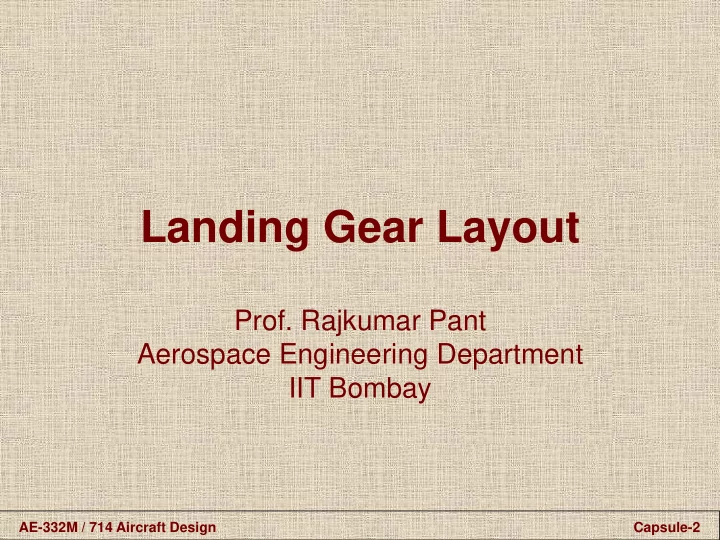

Landing Gear Layout Prof. Rajkumar Pant Aerospace Engineering Department IIT Bombay AE-332M / 714 Aircraft Design Capsule-2
Introduction Most difficult subsystem to design & configure Requirements Bear static loads while on ground Allow smooth transition during take-off Bear impact loads during landing Provide comfortable ride to the passengers Desired features Smallest possible size Lowest possible weight Least possible drag Least complexity during operation and maintenance Lowest operating cost AE-332M / 714 Aircraft Design Capsule-2
L G is a necessary evil ! Used only for less than 0.5% of a/c life Many attempts made for disposable LG Levasseur PL-8 Junkers Ju EF126 Elli B-52 (in the initial design requirements) AE-332M / 714 Aircraft Design Capsule-2
Levasseur PL-8 White Bird Levasseur PL.8 First to fly across the Atlantic Ocean nonstop (?) Open-cockpit biplane One 450 HP Piston Engine Watertight fuselage that could float on water AE-332M / 714 Aircraft Design Capsule-2
Junkers Ju EF126 Elli Rapidly producible inexpensive small fighter a/c Pulsejet powered, with propeller driven startup RATO, using detachable solid fuel rocket motors Droppable Take-off dolly, retractable landing skid AE-332M / 714 Aircraft Design Capsule-2
Various Layouts for Landing Gear AE-332M / 714 Aircraft Design Capsule-2
Landing Gear Arrangements AE-332M / 714 Aircraft Design Capsule-2
Tailwheel v/s Nosewheel Type Nosewheel Type Tailwheel Type Most common today Most common earlier Also called Tricycle Also called Tail dragger MLG strut(s) behind CG MLG struts ahead of CG Aux. wheel far ahead Aux. strut near rear end AE-332M / 714 Aircraft Design Capsule-2
Nosewheel and Tailwheel Type AE-332M / 714 Aircraft Design Capsule-2
Advantages of Nosewheel Type When on ground, the fuselage, cabin floor of the aircraft are roughly horizontal The view of the pilot when taxiing is relatively good. Nosewheel acts as a prop to prevent overturning during braking. Initial take off attitude has low drag The nose down pitch resulting from a two point landing helps to shed lift AE-332M / 714 Aircraft Design Capsule-2
Layout of Nosewheel Type AE-332M / 714 Aircraft Design Capsule-2
Advantages of Tailwheel Type Simplicity Small and light Tailwheel Ease in streamlining MLG Large AOA during ground roll Large ground clearance for nose propeller Ease in ground handling During braking, aircraft tends to pitch nose down increasing MLG reaction increased possibility of skidding reduced Easier to mount MLG onto suitable structure AE-332M / 714 Aircraft Design Capsule-2
Demerits of Tailwheel Type Instability in landing since CG is behind MLG If single leg hits ground, then a/c tends to swing in that direction Pilot has to ensure symmetric landing Inclined fuselage floor while on ground Poor pilot visibility during taxiing Difficulty in Cargo and passenger handling / serving Increased pressure on fuel pump due to inclination AE-332M / 714 Aircraft Design Capsule-2
Layout of Tailwheel type AE-332M / 714 Aircraft Design Capsule-2
Layout of Tailwheel type AE-332M / 714 Aircraft Design Capsule-2
Bicycle Type Two MLG and small outrigger wheels Used when Central fuselage is already occupied Large CG movement is expected AE-332M / 714 Aircraft Design Capsule-2
Merits and Demerits of Bicycle layout Disadvantages: Advantages: Outriggers necessary MLG located roughly aft of The aircraft landing attitude the CG. must be carefully controlled Wheels are located on the Considerable elevator centerline of the aircraft power for nosewheel liftoff AE-332M / 714 Aircraft Design Capsule-2
Examples of Bicycle type AE-332M / 714 Aircraft Design Capsule-2
Bicycle landing gear geometry AE-332M / 714 Aircraft Design Capsule-2
Single Wheel Type Subcategory of the Bicycle Type Single MLG with small Aux. wheel Outriggers needed for stability AE-332M / 714 Aircraft Design Capsule-2
Advantages of Single Wheel Type Simple, lightweight, and low drag May include skids rather than wheels Used on light planes like gliders and sailplanes Generally impractical for larger aircraft Example: U-2 Reconnaissance aircraft Removable outriggers (Pogos) AE-332M / 714 Aircraft Design Capsule-2
Quadricycle Type Subset of Bicycle type MLG at the side of fuselage Advantages Low cargo floor for easy loading / unloading Lateral stability without outrigger wheels AE-332M / 714 Aircraft Design Capsule-2
Multibogey Type No. of wheels per strut W TO ≤ 50,000 lb One 50,000 ≤ W TO ≤ 200,000 lb Two 200,000 ≤ W TO ≤ 400,000 lb Four W TO ≥ 400,000 lb Six AE-332M / 714 Aircraft Design Capsule-2
LG of AN-225 Mriya Seven pairs of wheels on MLG, two pairs on nosewheels Possible to adjust pressure of each tire on MLG AE-332M / 714 Aircraft Design Capsule-2
L G layout for higher floatation Track Type Layout Reduces loading on runway Operation from soft ground / unprepared strips AE-332M / 714 Aircraft Design Capsule-2
Recommend
More recommend